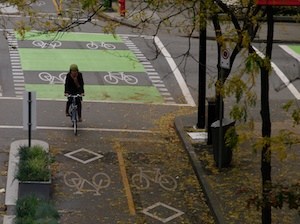A fact sheet and answers to frequently asked questions about our Carfree Mobility Network Grant Program

© California Bicycle Coalition 2025

1017 L Street #288
Sacramento, CA 95814
© California Bicycle Coalition 2025

Protected / Separated bicycle lane on Dunsmuir Street, downtown Vancouver, Canada
California’s communities are getting better for bicycling, one bikeway at a time – and that’s the problem. Bikeways often disappear right when we need them most, dumping us into a shared lane with high-speed traffic.
We need complete, low-stress bike networks, but state funding programs tend to support single, stand-alone bikeways, and no program exists to build whole networks. As a result, political leaders and transportation planners defer development of the politically difficult or higher cost projects, which may be more impactful, in favor of the easier ones. This process leaves gaps in the network that make it as useful to the typical traveler as a chain with a missing link is for security. CalBike is committed to changing this.
Our proposal is to create a competitive grant program that will provide significant funding to communities willing to build complete networks, without gaps, to a very high safety standard, and therefore significantly increase bicycle mode share.
What does a complete bikeway network mean for people on bikes? It means no more “Bike Lane Ends” signs, leaving riders with nowhere to go. No more need to navigate fast-moving traffic on wide, busy streets. No more stressful intersections without a safe way for a person on a bike to cross. Instead, people on bikes can choose to ride on off-street bike paths, quiet neighborhood streets, and, when the best way to get there is along those busy streets, protected bike lanes. People can choose to ride a bike, and feel comfortable riding wherever they need to go.